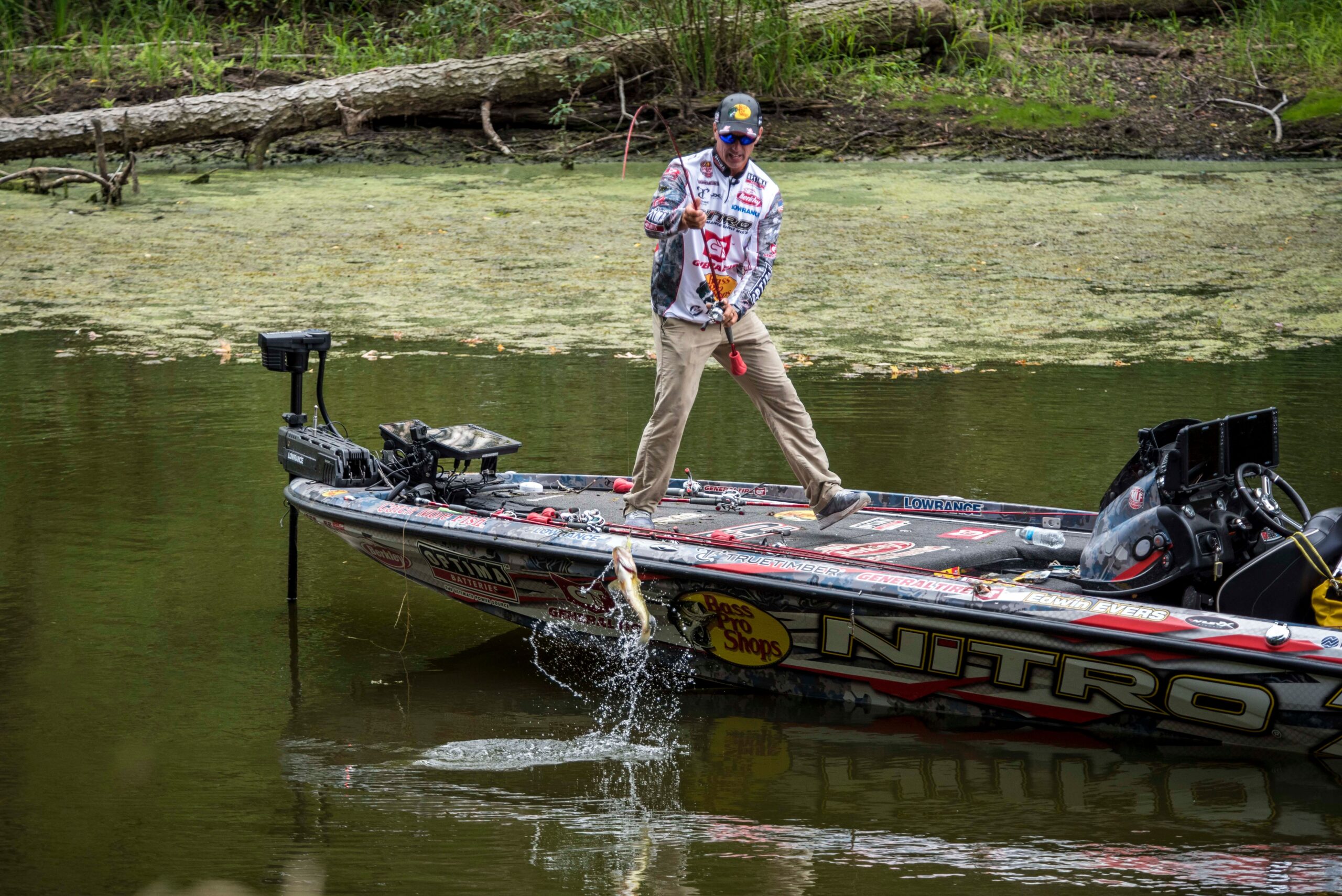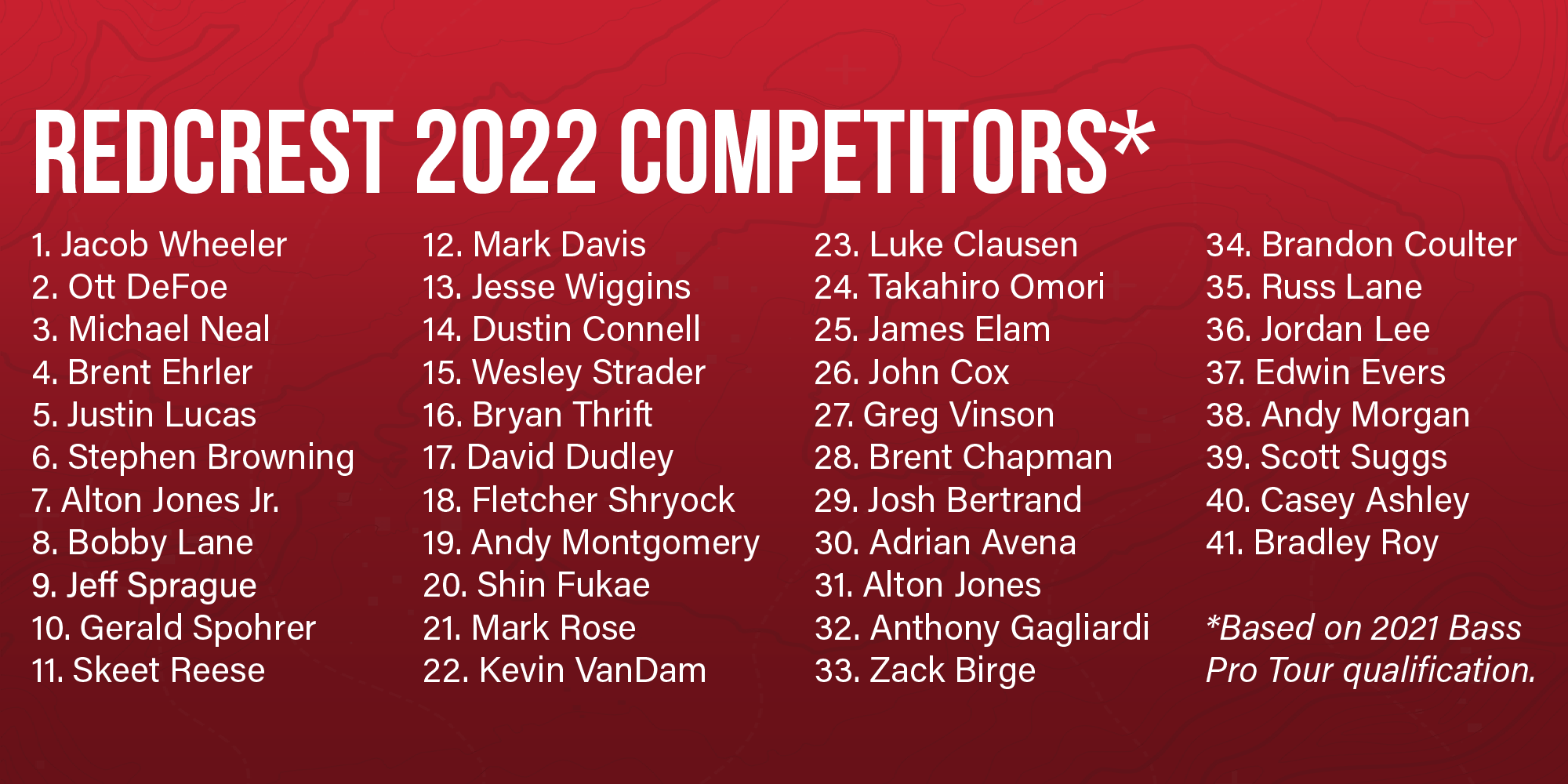Who’s Next? A Grand Arena for REDCREST 2022
March 23-27 Bass Pro Tour Championship and Expo Bring Biggest, Best to Tulsa

TULSA, Okla. – It’s been a championship date two years in the making, but come March 23-27, 41 of the best bass anglers in the world will take to Grand Lake O’ The Cherokees in northeast Oklahoma for a shot at the coveted REDCREST trophy and the $300,000 payday that comes with it.
The 46,000-acre impoundment of the Grand River system in the Ozark foothills was originally slated as the competition grounds for REDCREST 2021, but that event – won by Alabama pro Dustin Connell – was eventually contested in Alabama, after extreme winter storms forced its relocation from Grand to Lake Palestine, Texas, and finally to Lake Eufaula.
Grand Lake is a fitting venue for the third-ever REDCREST: it’s located 90 miles northeast of Major League Fishing headquarters in Tulsa, and boasts a rich tournament history that includes career-defining moments for multiple anglers in the 41-man field (including inaugural REDCREST champion/Oklahoma native Edwin Evers).
“I was lucky enough to win the first REDCREST (in 2019), and I really want to win it again here at home,” Evers admitted.
The Grand Lake Setup
Grand Lake O’ the Cherokees is the official name of the lake created with the completion of the Pensacola Dam on the Lower Neosho River in 1940. Grand is a relatively large lake with more than 46,000 surface acres and 1,366 miles of shoreline, and an abundance of cover and fishable water that make it an immensely popular and productive fishery.
“One of the great things about Grand is that there’s just so much to fish,” said Oklahoma native Zack Birge, who has collected Toyota Series and Phoenix Bass Fishing League wins on Grand Lake. “It’s consistent with rock pretty much everywhere around the entire lake and then you have docks and some isolated wood mixed in. You also have steep banks, creek channels and flats – all of those will hold fish at times.”
Grand Lake is deep by Oklahoma standards, averaging 36.3 feet. According to REDCREST 2022 Presented by Costa qualifier James Elam (who won a BASS Open on Grand in 2017 and climbed the tournament ranks fishing Grand Lake and other Oklahoma waters), water clarity varies, depending on which section of the lake you’re fishing.
“You have clear water down by the dam and the water gets dirtier up the lake when it gets flatter and you start to have more mud banks,” Elam said. “Then it gets cleaner again when you go further up the river.”

By all accounts, the fishing quality has been improving on the fishery and the late spring timing of REDCREST should offer hefty largemouth moving shallow after leaving their deeper winter holding depths.
Fisheries biologist Steven Bardin – the co-manager of MLF’s Fisheries Management Division – describes Grand Lake as a healthy fishery based on angler studies and electrofishing performed by the Oklahoma Department of Wildlife Conservation.
“It is rare to have a lake this size with the size of fish and it’s a testament to the forage base of shad and management of the lake,” Bardin said. “One big thing that happened recently is the partnership between the city of Grove and the Oklahoma Department of Wildlife Conservation in placing 250 pieces of MossBack Fish Habitat near the popular Honey Creek State Park Ramp. The ramp is what many five-fish tournaments use, and the habitat was all placed in 10 to 14 feet of water and will serve as places that fish can stage and recover after being released. It will greatly help the fishery and the state has an interactive map where anglers can get all of the coordinates of each piece of habitat to load into their electronics and fish.”
Grand Lake Tournament History
Although it’s been the site of multiple Toyota, BFL and College events, REDCREST 2022 will be the first tournament on Grand Lake held under MLF’s catch, weigh, immediate-release format and 2-pound scorable-size minimum.
While the 41 REDCREST qualifiers haven’t fished Grand under MLF rules, the majority of the anglers in the field are very familiar with it from Toyota Series, BFL and other tour-level competitions. Grand Lake has hosted two Bassmaster Classics won by MLF anglers, Cliff Pace in February of 2013 and Evers in March of 2016.
Pace did not qualify for REDCREST 2022, but Evers will be competing and has a chance to become the first two-time REDCREST champion after claiming the inaugural event in 2019 on the Upper Mississippi River in Wisconsin.
Kevin VanDam is another angler in the field with past success on Grand Lake: He collected two Bassmaster Elite Series wins here (in 2007 and 2018).
Those events were in a five-fish-limit format and the winning totals equated to roughly a 4-pound per-fish average. It’ll be a much different scenario at REDCREST as anglers will count as many scoreable bass over 2 pounds as they can catch in a day.

Evers Expects REDCREST Excellence
Evers will enter REDCREST as one of the odds-on favorites. The 2019 Bass Pro Tour Angler of the Year is intimately familiar with Grand Lake, and lives roughly an hour away from the lake in Talala, Oklahoma. Evers is one of a handful of anglers who can refer back to a wealth and success on the fishery, including the 2016 Classic win and a pair of Top 5s on Grand in Elite competition.
Evers’ Classic win came in early March – the Berkley pro believes the fishing will be much better for the entire field because of the late-March timing of REDCREST.
“Late March is the best fishing of the entire year on Grand Lake,” he said. “It’s a time of year when you can catch fish just about any way you want to, and guys can fish their strengths. It’s the best time of year to catch them on a variety of techniques, and up and down the whole lake.”
While there will likely be a wide variety of baits and depths in play, Evers points to a trio of Grand Lake standbys to be the biggest players come late March.
“Crankbaits, jerkbaits, and jigs will be the primary baits, like they are on Grand every year in the late winter and spring,” he said. “It’s typical prespawn stuff and we should be right in that late-winter and prespawn stage. If we get a good warming trend, there could also be some fish spawning, but I believe it will mainly be prespawn patterns.”
Weather is the Wildcard
As is the case during any early spring tournament, the weather will certainly factor into the five-day REDCREST competition window.
Current forecasts call for a dramatic drop in temperature during practice – from a high of 80 degrees on the first practice day to a high of 59 and thunderstorms the second day. Day 1 of REDCREST could see a continued drop (daytime high of 50, low of 37), but then steadily improving to a high of 74 degrees by Championship Sunday on March 27.
Mercurial weather notwithstanding, Bardin believes REDCREST week will be heavily focused on bass preparing to spawn, with the possibility of some fish spawning, and a small percentage settling into a postspawn pattern.
“March is prime time in the central parts of the country and there could be fish in all phases of the spawn – anglers should be able to fish a variety of different techniques,” Bardin said. “The upper end of the lake will be dirtier and warm up faster than lower on the lake, where the water is fairly clear and stays cold longer. The fish down the lake will likely be a few weeks behind the other fish for spawning.”

Pattern Predictions
There are generally many ways to catch bass in the spring, but Elam agrees with Evers’ assessment that a small handful of baits will be the most productive at REDCREST.
“Jigs and crankbaits are the meat and potatoes on Grand,” Elam said. “Those baits will catch fish all year long, you just have to adjust sizes and weights for different seasons. This tournament should be shallow-diving crankbaits and squarebills, and fishing jigs up shallow around the bank. Two other possibilities are jerkbaits and spinnerbaits.”
Birge echoes that assessment.
“It’s a safe bet to say that a crankbait and jig will be the two most dominant baits,” Birge said. “They’ll catch a bunch of fish, and if it warms up nicely, fishing shallow with a jig could be the way to win it.”
Elam believes that any section of the lake could produce the winning fish, and that there are groups of potential winning fish swimming from one end of the lake to the other
“I could see the tournament being won anywhere on Grand Lake, it just depends on which area proves to be the hottest while we’re there,” he said. “The lake fishes very big and it’s a place you can run patterns to catch fish. I think we’ll see guys spread out up and down the whole lake, I don’t think you’ll see groups of guys gathered in one or two areas.”

The State of Grand Lake and Predictions
Lakes go through cycles – peaks and valleys in fish populations and fishing quality – and the three Oklahomans in the field believe that Grand Lake is in an excellent point in its cycle as a top-flight tournament fishery.
“It’s in great shape right now and the lake is full of 2 ½- to 3 ½-pound bass with some bigger ones mixed in,” Evers said. “There are plenty of quality fish in there, and I’d say a good day on Grand in late March would be 15 scoreable bass over 2 pounds.”
Grand receives plenty of fishing pressure from recreational and tournament anglers alike, and both Birge and Elam have paid attention to tournament results to gauge the fishing quality.
“I haven’t fished Grand as much regularly as I used to, but I still watch what’s going on and it looks like it’s fishing pretty good this last year,” Elam said. “It’s not to the level it was years ago, but after a few down years, it’s picking back up.”
Elam believe that coaxing quality bites will be critical because big numbers of fish are not as likely to be available in late March.
“Late winter and early spring are not the best times of year for sheer numbers of fish, but we’ll see some nice ones caught,” Elam said. I’m guessing a day with seven or eight bass will get you over 20 pounds and that’ll be enough to advance to the next round. Then, whoever makes the right calls in the Championship Round and gets on them will take the win. I wouldn’t be surprised if it’s someone who barely gets into the Knockout and Championship rounds and then puts it all together after the weights are zeroed on the final day.”
Birge also believes that the lake is on an upward swing for fishing quality based on tournament results.
“This fall was really good, they were catching solid bags,” he said about tournament results, including the Phoenix Bass Fishing League Okie Division finale in September. “I think the lake is getting better and we’re in a good part of the cycle right now.”
Recent science seems to back up those tournament results. Bardin is also part of the committee that decides the minimum weight for each Bass Pro Tour event. The goal is to showcase each fishery while setting the minimum for each tournament to be obtainable, but not easy.
“A 14-inch fish on Grand Lake is the minimum legal keeper and, on average, weighs 1.42 pounds,” Bardin said. “Through the most recent data available, we found that 74% of the legal fish in the lake were over 2 pounds, with fish between 2 and 3 pounds accounting for 35% of the fish. The lake is very healthy and is a testament to the forage base and resiliency after two years of spring flooding. Those floods allowed for great recruitment of young bass after the spawn and there will be a huge influx of catchable bass in the coming years.”
